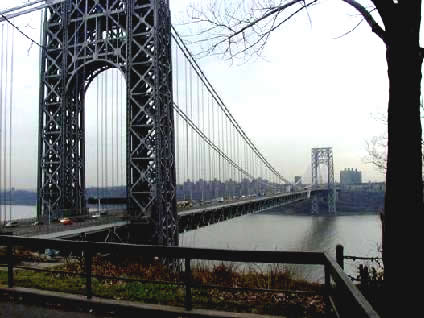History
 For four generations a familiar sight has graced the Hudson River that has connected New York and New Jersey. The George Washington Bridge, opened on October 25, 1931, is a tribute of civil engineering to the people who conceived, built and made the bridge what it is today.
For four generations a familiar sight has graced the Hudson River that has connected New York and New Jersey. The George Washington Bridge, opened on October 25, 1931, is a tribute of civil engineering to the people who conceived, built and made the bridge what it is today.
Prior to the conception of the George Washington Bridge there were numerous proposals for a bridge spanning the Hudson River. Between the years of 1866 and 1927, six companies offered eighteen different designs, and five different locations were considered for construction. One of the earlier proposals was for rail traffic with the use of a cantilever-designed bridge. As time progressed, tunnels were build from lower Manhattan to New Jersey to handle rail traffic, thus pushing the location of a bridge further upriver.
In 1890 legislation was passed in New York stipulating that any construction of a bridge should not have any piers in the river as this would have impeded river traffic delivering goods between New York City and small towns along the Hudson River, such as Albany, Garrison and Tarrytown. This was similar to legislation that had already been passed in New Jersey.
In April 1921 the Port Authority of New York and New Jersey was organized. Governor George A. Silzer of New Jersey had given preliminary plans, which had been drawn by Othmar Ammann, to the Port Authority for consideration. Four years later New York and New Jersey passed legislation to construct, operate and maintain a bridge across the Hudson River between 170th Street and 185th Street. By August 1926, Governor Silzer and Governor Smith had agreed to 179th Street for a suspension bridge connecting the two states.